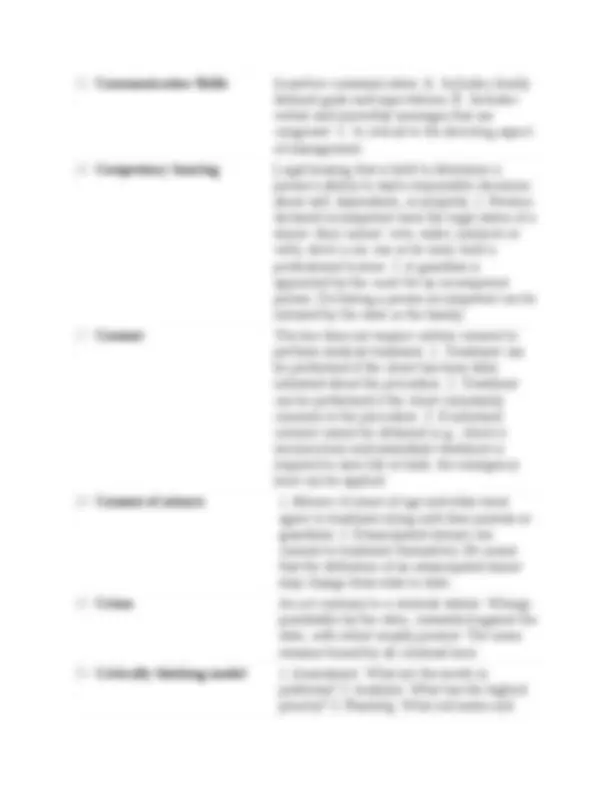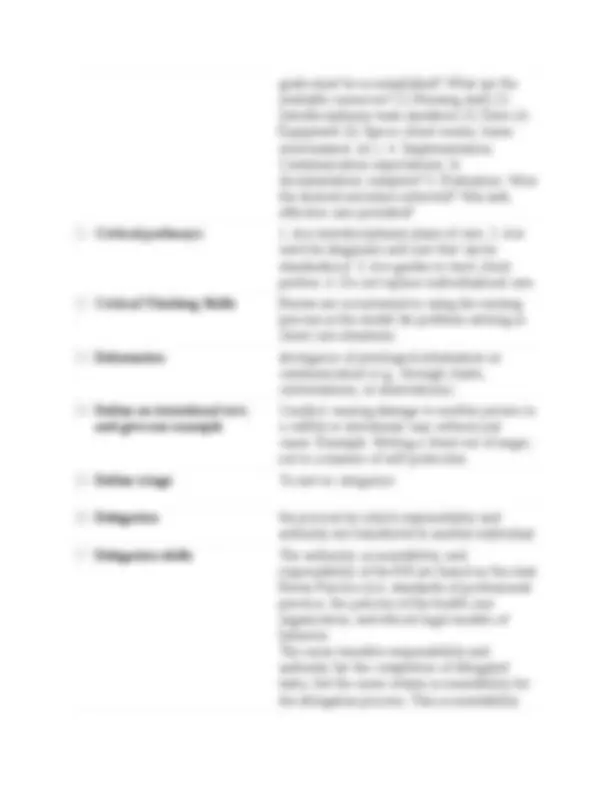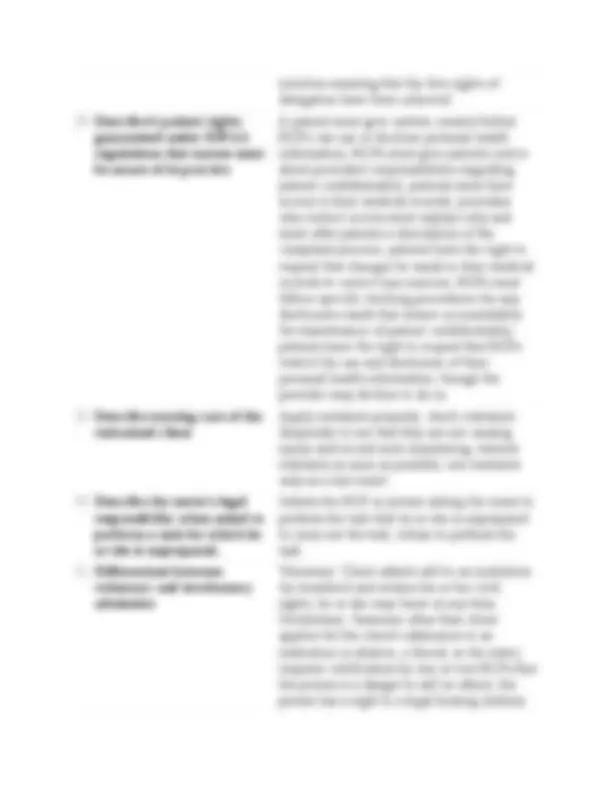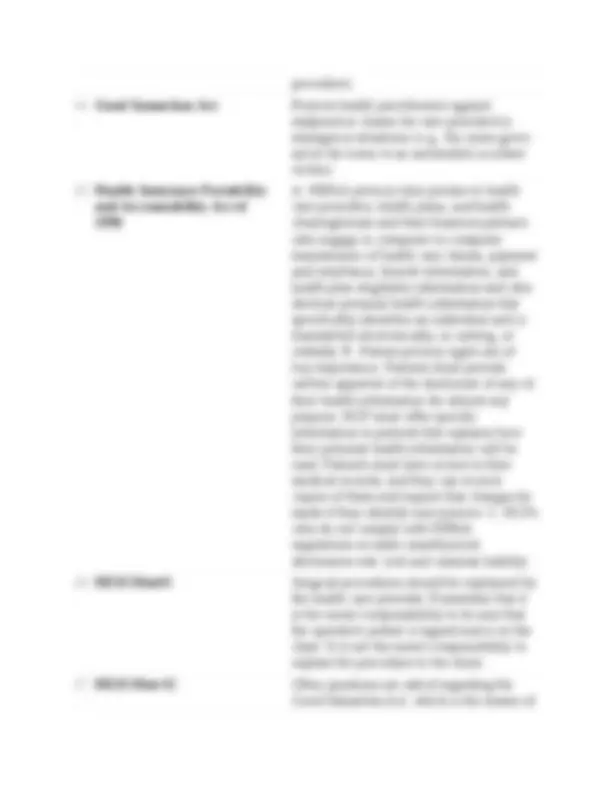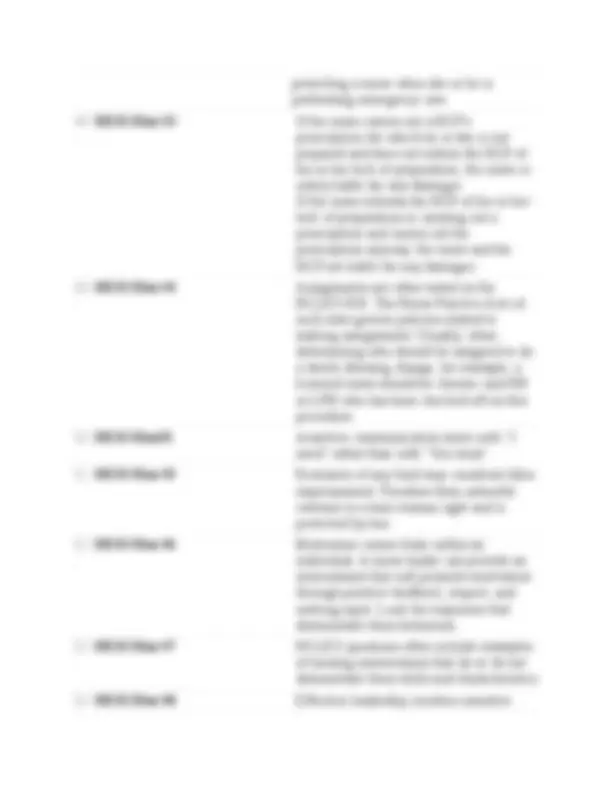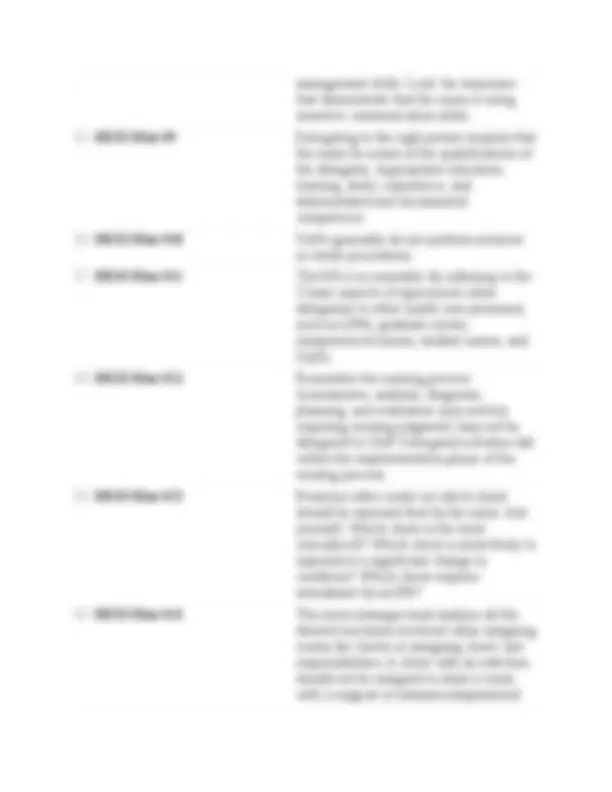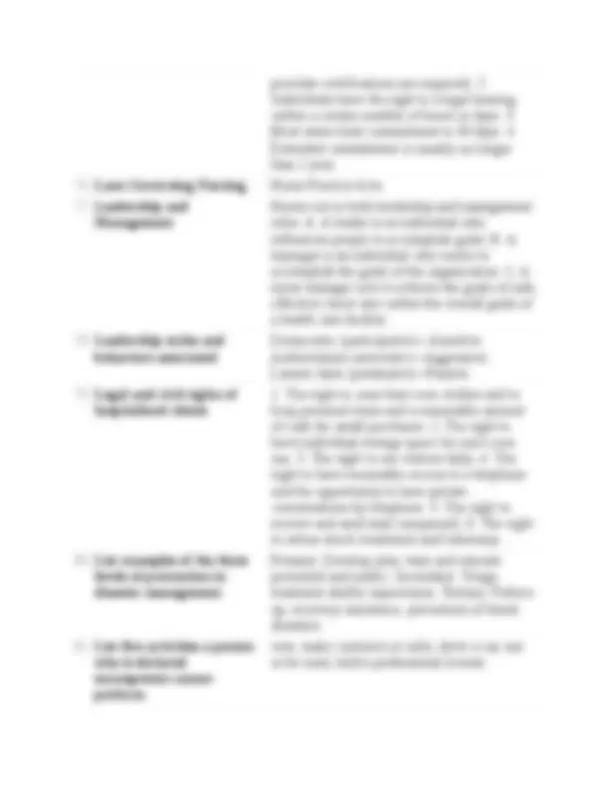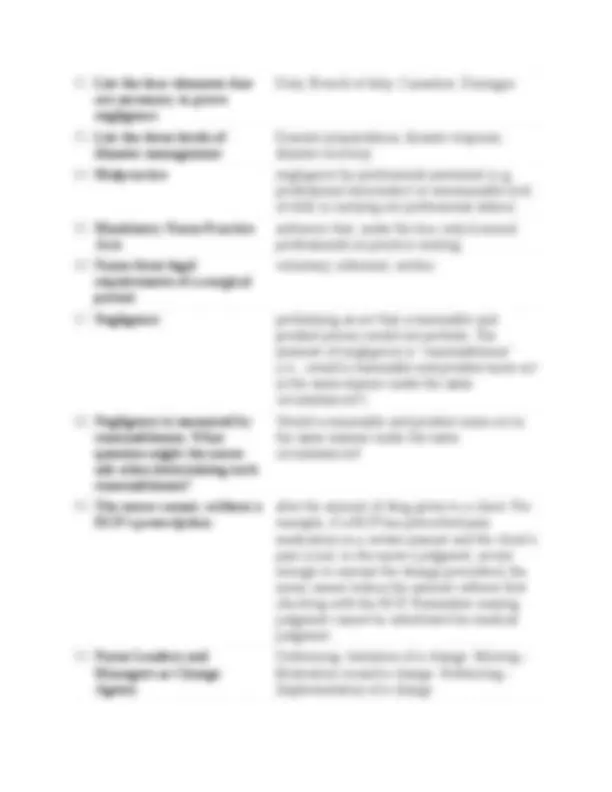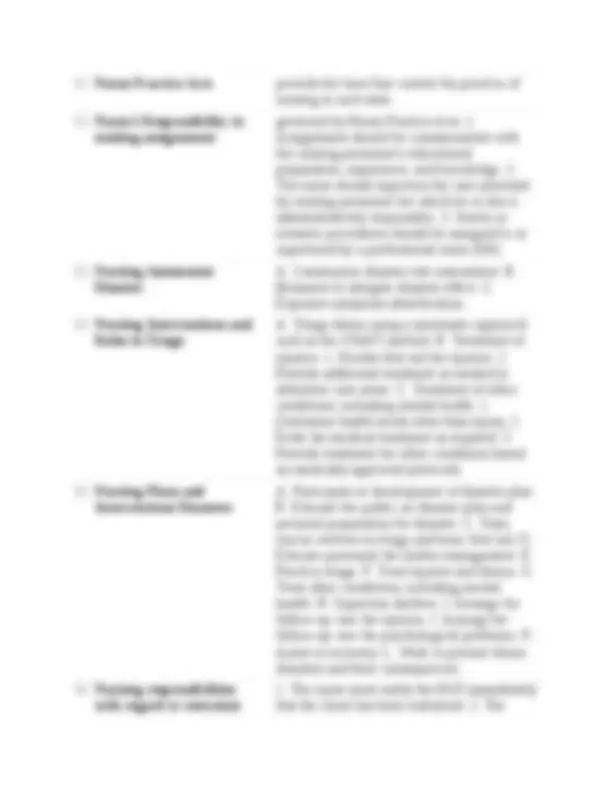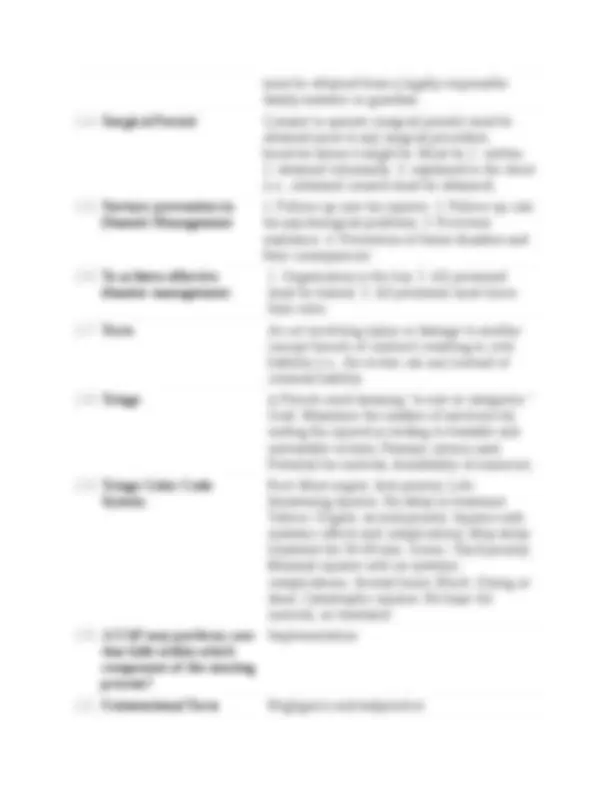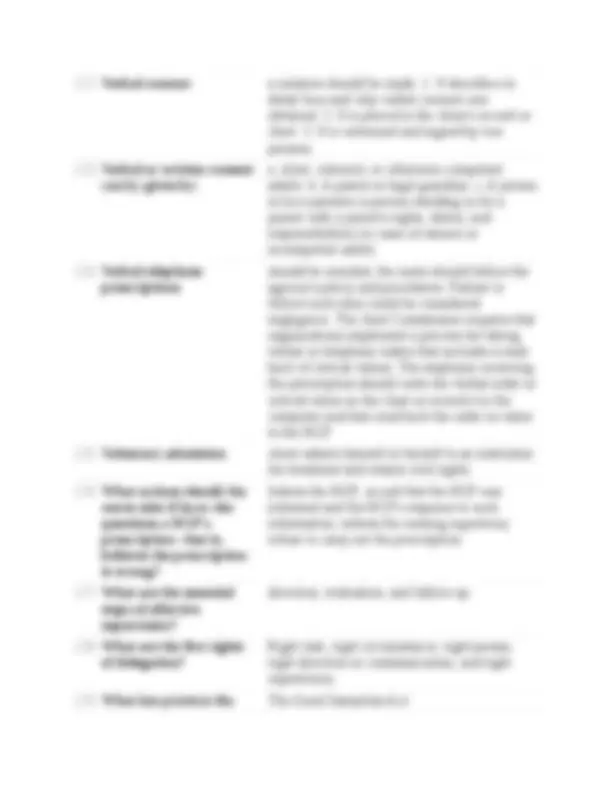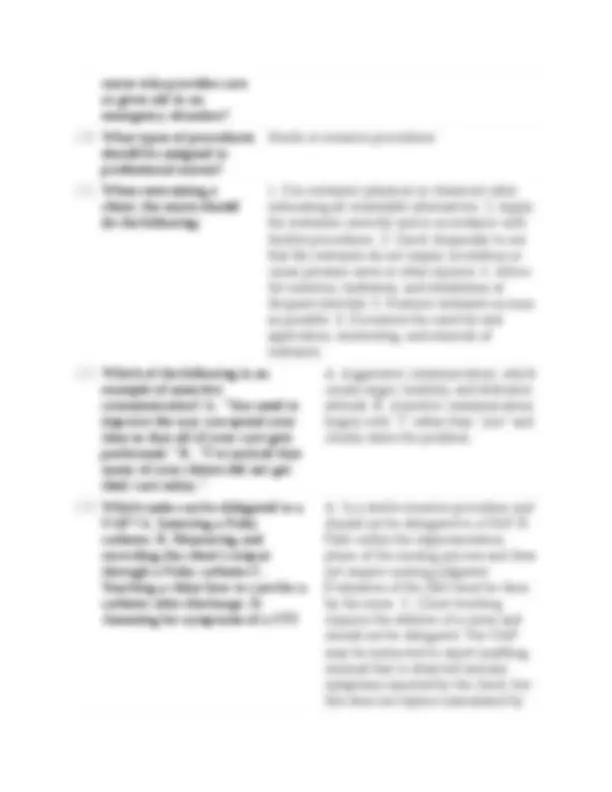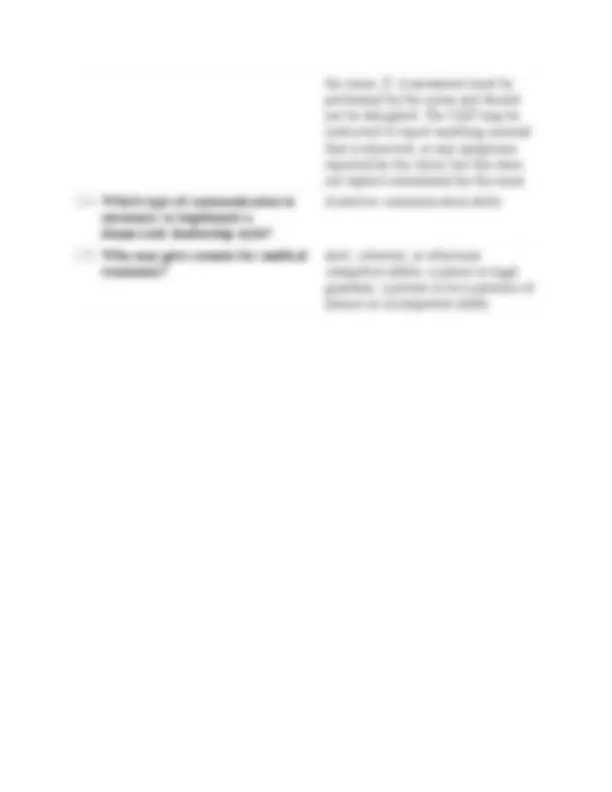Download Leadership/Management Nursing HESI and more Study notes Chemical Thermodynamics in PDF only on Docsity!
Leadership/Management Nursing HESI
- Accountability the ability and willingness to assume responsibility for actions and related consequences.
- Assault Mental or physical threat (e.g., forcing [without touching] a client to take a medication or treatment)
- Authority the right to act or command the actions of others
- Battery touching, with or without the intent to do harm (e.g., hitting or striking a client). If a mentally competent adult is forced to have a treatment he or she has refused, battery occurs.
- Biologic agents A. Anthrax. B. Pneumonic plague. C. Botulism. D. Smallpox. E. Inhalation tularemia. F. Viral hemorrhagic fever
- Bioterrorism A. Learn the symptoms of illnesses that are associated with exposure to likely biologic and chemical agents. B. Understand that they could appear days or weeks after exposure. C. Nurses and other HCPs would be the first responders when victims seek medical evaluation after symptoms manifest. First responders are critical in identifying an outbreak, determining cause of outbreak, identifying risk factors, and implementing measures to control and minimize the outbreak.
- Breach of duty failure to perform according to the established standard of conduct in providing nursing care
- By what authority may RNs delegate nursing care to others? State Nurse Practice Act
- Case management: 1. Coordination of care provided by an interdisciplinary team. 2. Manages resources
effectively. 3. Uses critical pathways to organize care 10 . Causation a connection exists between conduct and the resulting injury referred to as "proximate cause" or "remoteness of damage"
- Chemical agents A. Biotoxin agents: ricin. B. Nerver agents: sarin 12 . Civil procedures methods used to protect the rights of psychiatric clients 13 . Collaborative health care teams require;
- Shared goals, commitment, and accountability. 2. Open and clear communication. 3. Respect for the expertise of all team members. 14 . Commission of a crime involves...
- A person commits a deed contrary to criminal law. 2. A person omits an act when there is a legal obligation to perform such an act (e.g., refusing to assist with the birth of a child if such a refusal results in injury to the child). 3. Criminal conspiracy occurs when two or more persons agree to commit a crime.
- Assisting or giving aid to a person in the commission of a crime makes that person equally guilty of the offense (awareness must be present that the crime is being committed).
- Ignoring a law is not usually an adequate defense against the commission of a crime (e.g., a nurse who sees another nurse taking narcotics from the unit supply and ignores this observation is not adequately defended against committing a crime). 6. Assault is justified for self-defense. However, to be justified, only enough force can be used as to maintain self- protection. 7. Search warrants are required prior to searching a person's property. 8. It is a crime not to report suspected child abuse (i.e., the nurse's legal responsibility is to report suspected child abuse)
goals must be accomplished? What are the available resources? (1) Nursing staff (2) Interdisciplinary team members (3) Time (4) Equipment (5) Space (client rooms, home environment, etc.). 4. Implementation: Communication expectations. Is documentation complete? 5. Evaluation: Were the desired outcomes achieved? Was safe, effective care provided? 21 . Critical pathways: 1. Are interdisciplinary plans of care. 2. Are used for diagnoses and care that can be standardized. 3. Are guides to track client profess. 4. Do not replace individualized care 22 . Critical Thinking Skills Nurses are accustomed to using the nursing process as the model for problem-solving in client care situations. 23 . Defamation divulgence of privileged information or communication (e.g., through charts, conversations, or observations) 24 . Define an intentional tort, and give one example Conduct causing damage to another person in a willful or intentional way without just cause. Example: Hitting a client out of anger, not in a manner of self-protection 25 . Define triage To sort or categorize 26 . Delegation the process by which responsibility and authority are transferred to another individual 27 . Delegation skills The authority, accountability, and responsibility of the RN are based on the state Nurse Practice Act, standards of professional practice, the policies of the health care organization, and ethical-legal models of behavior. The nurse transfers responsibility and authority for the completion of delegated tasks, but the nurse retains accountability for the delegation process. This accountability
involves ensuring that the five rights of delegation have been achieved 28 . Describe 6 patient rights guaranteed under HIPAA regulations that nurses must be aware of in practice A patient must give written consent before HCPs can use or disclose personal health information; HCPs must give patients notice about providers' responsibilities regarding patient confidentiality; patients must have access to their medical records; providers who restrict access must explain why and must offer patients a description of the complaint process; patients have the right to request that changes be made in their medical records to correct inaccuracies; HCPs must follow specific tracking procedures for any disclosures made that ensure accountability for maintenance of patient confidentiality; patients have the right to request that HCPs restrict the use and disclosure of their personal health information, though the provider may decline to do so. 29 . Describe nursing care of the restrained client Apply restraints properly; check restraints frequently to see that they are not causing injury and record such monitoring; remove restraints as soon as possible; use restraints only as a last resort. 30 . Describe the nurse's legal responsibility when asked to perform a task for which he or she is unprepared. Inform the HCP or person asking the nurse to perform the task that he or she is unprepared to carry out the task; refuse to perform the task. 31 . Differentiate between voluntary and involuntary admission Voluntary: Client admits self to an institution for treatment and retains his or her civil rights; he or she may leave at any time. Involuntary: Someone other than client applies for the client's admission to an institution (a relative, a friend, or the state); requires certification by one or two HCPs that the person is a danger to self or others; the person has a right to a legal hearing (habeas
Exposure of a person Exposure or discussion of a client's case. After death, a client has the right to be unobserved, excluded from unwarranted operations, and protected from unauthorized touching of the body. 39 . False imprisonment confinement without authorization 40 . Five Rights of Delegation 1. Right task: Is this a task that can be delegated by a nurse? 2. Right circumstance: Considering the setting and available resources, should delegation take place? 3. Right person: Is the task being delegate by the right person to the right person? 4. Right direction/communication: Is the nurse providing a clear, concise description of the task, including limits and expectations? 5. Right supervision: Once the task has been delegate, is appropriate supervision maintained/ 41 . Follow-up 1. Communication of evaluation findings to the LPN or UAP and other appropriate personnel. 2. Need for teaching or guidance. 42 . Four elements necessary to prove negligence or malpractice duty, breach of duty, injury/damages, causation 43 . Fraud willful and purposeful misrepresentation that could cause, or has caused, loss or harm to a person or property. Examples of fraud include: 1. Presenting false credential for the purpose of entering nursing school, obtaining a license, or obtaining employment. 2. Describing a myth regarding a treatment (e.g., telling a client that a placebo has not side effects and will cure the disease or telling a client that a treatment or diagnostic test will not hurt, when indeed pain is involved in the
procedure) 44 . Good Samaritan Act Protects health practitioners against malpractice claims for care provided in emergency situations (e.g., the nurse gives aid at the scene to an automobile accident victim) 45 . Health Insurance Portability and Accountability Act of 1996 A. HIPAA privacy rules pertain to health care providers, health plans, and health clearinghouses and their business partners who engage in computer-to-computer transmission of health care claims, payment and remittance, benefit information, and health plan eligibility information and who disclose personal health information that specifically identifies an individual and is transmitted electronically, in writing, or verbally. B. Patient privacy rights are of key importance. Patients must provide written approval of the disclosure of any of their health information for almost any purpose. HCP must offer specific information to patients that explains how their personal health information will be used. Patients must have access to their medical records, and they can receive copies of them and request that changes be made if they identify inaccuracies. C. HCPs who do not comply with HIPAA regulations or make unauthorized disclosures risk civil and criminal liability. 46 . HESI Hint#1 Surgical procedures should be explained by the health care provider. Remember that it is the nurse's responsibility to be sure that the operative permit is signed and is on the chart. It is not the nurse's responsibility to explain the procedure to the client. 47 . HESI Hint #2 Often questions are asked regarding the Good Samaritan Act, which is the means of
. management skills. Look for responses that demonstrate that the nurse is using assertive communication skills 55 . HESI Hint #9 Delegating to the right person requires that the nurse be aware of the qualifications of the delegatee: Appropriate education, training, skills, experience, and demonstrated and documented competence. 56 . HESI Hint #10 UAPs generally do not perform invasive or sterile procedures 57 . HESI Hint #11 The RN is accountable for adhering to the 3 basic aspects of supervision when delegation to other health care personnel, such as LPNs, graduate nurses, inexperienced nurses, student nurses, and UAPs. 58 . HESI Hint #12 Remember the nursing process: Assessments, analysis, diagnosis, planning, and evaluation (any activity requiring nursing judgment) may not be delegated to UAP. Delegated activities fall within the implementation phase of the nursing process. 59 . HESI Hint #13 Priorities often center on which client should be assessed first by the nurse. Ask yourself: Which client is the most critically ill? Which client is most likely to experience a significant change in condition? Which client requires assessment by an RN? 60 . HESI Hint #14 The nurse manager must analyze all the desired outcomes involved when assigning rooms for clients or assigning client care responsibilities. A client with an infection should not be assigned to share a room with a surgical or immunocompromised
client. A nurse's client care management should be based on the nurse;s abilities, the individual client's needs, and the needs of the entire group of assigned clients. Safety and infection control are high priorities 61 . HESI Hint #15 Change causes anxiety. An effective nurse change agent uses problem-solving skills to recognize factors such as anxiety that contribute to resistance to change and uses decision-making and interpersonal skills to overcome that resistance. Interventions that demonstrate these skills include seeking input, showing respect, valuing opinions, and building trust. 62 . HESI Hint #16 It is important to remember that in disaster and bioterrorism management, the nurse must consider both the individual and the community. 63 . Hospital policies provide a guide for nursing actions. They are not laws, but courts generally rule against nurses who have violated the employer's policies. Hospital can be liable for poorly formulated or poorly implemented policies 64 . Identify three bioterrorism agents Anthrax, pneumonic plague, botulism, smallpox, inhalation tularemia, viral hemorrhagic fever, ricin, sarin, radiation. 65 . If a nurse is asked to perform a task for which he or she has not been prepared educationally or does not have the necessary experience:
- Inform the HCP that he or she does not have the education or experience necessary to carry out the prescription. 2. Refuse to carry out the prescription
- If a nurse questions a HCP's prescription because he or she believes that it is wrong:
- Inform the HCP. 2. Record that the HCP was informed and record the HCP's response to such information. 3. Inform the nursing supervisor. 4. Refuse to carry out the
provider certifications are required). 2. Individuals have the right to a legal hearing within a certain number of hours or days. 3. Most states limit commitment to 90 days. 4. Extended commitment is usually no longer than 1 year.
- Laws Governing Nursing Nurse Practice Acts
- Leadership and Management Nurses act in both leadership and management roles. A. A leader is an individual who influences people to accomplish goals. B. A manager is an individual who works to accomplish the goals of the organization. C. A nurse manager acts to achieve the goals of safe, effective client care within the overall goals of a health care facility.
- Leadership styles and behaviors associated Democratic (participative)--Assertive. Authoritarian (autocratic)--Aggressive. Laissez-faire (permissive)--Passive.
- Legal and civil rights of hospitalized clients
- The right to wear their own clothes and to keep personal items and a reasonable amount of cash for small purchases. 2. The right to have individual storage space for one's own use. 3. The right to see visitors daily. 4. The right to have reasonable access to a telephone and the opportunity to have private conversations by telephone. 5. The right to receive and send mail (unopened). 6. The right to refuse shock treatments and lobotomy.
- List examples of the three levels of prevention in disaster management Primary: Develop plan, train and educate personnel and public. Secondary: Triage, treatment-shelter supervision. Tertiary: Follow- up, recovery assistance, prevention of future disasters.
- List five activities a person who is declared incompetent cannot perform vote, make contracts or wills, drive a car, sue or be sued, hold a professional license.
- List the four elements that are necessary to prove negligence Duty. Breach of duty. Causation. Damages
- List the three levels of disaster management Disaster preparedness, disaster response, disaster recovery.
- Malpractice negligence by professional personnel (e.g., professional misconduct or unreasonable lack of skill in carrying out professional duties)
- Mandatory Nurse Practice Acts authorize that, under the law, only licensed professionals an practice nursing.
- Name three legal requirements of a surgical permit voluntary, informed, written
- Negligence performing an act that a reasonable and prudent person would not perform. The measure of negligence is "reasonableness" (i.e., would a reasonable and prudent nurse act in the same manner under the same circumstances?)
- Negligence is measured by reasonableness. What question might the nurse ask when determining such reasonableness? Would a reasonable and prudent nurse act in the same manner under the same circumstances?
- The nurse cannot, without a HCP's prescription: alter the amount of drug given to a client. For example, if a HCP has prescribed pain medication in a certain amount and the client's pain is not, in the nurse's judgment, severe enough to warrant the dosage prescribed, the nurse cannot reduce the amount without first checking with the HCP. Remember nursing judgment cannot be substituted for medical judgment.
- Nurse Leaders and Managers as Change Agents Unfreezing--Initiation of a change. Moving-- Motivation toward a change. Refreezing-- Implementation of a change
nurse should document the facts regarding the rationale for restraining the client.
- Organizational Skills encompass management of: A. people. B. time. C. supplies
- Patient Identification A. The Joint Commission has implemented new patient identification requirements to meet safety goals. B. Use at least two patient identifies whenever taking blood samples, administering meds, or administering blood products. C. The patient room number may not be used as a form of identification.
- Possible agents. Biologic agents. Chemical agents. Radiation.
- Prescriptions and HCPs A nurse is required to obtain a prescription (order) to carry out medical procedures from a HCP.
- Primary prevention in Disaster Management
- Participate in the development of a disaster plan. 2. Train rescue workers in triage and basic first aid. 3. Educate personnel about shelter management. 4. Educate the public about the disaster plan and personal preparation for disaster
- Psychiatric Nursing Practice and the Law Civil procedures, Voluntary admission, Involuntary admission, Emergency admission, Legal and civil rights of hospitalized clients, competency hearing, insanity, inability to stand trial.
- Quality assurance: 1. Involves continuous quality improvement (CQI)/total quality management (TQM). 2. Is an organized approach to the improvement of: Outcome achievement, Quality of care provided.
- Responsibility the obligation to complete a task
- Restraints Clients may be restrained only under the following circumstances: 1. in an emergency. 2. for a limited time. 3. for the purpose of protecting the client from injury or from harm
- The role of the nurse 1. Disaster preparedness. 2. Disaster response. 3.
takes place at all three levels of disaster management: Disaster recovery
- Secondary prevention in Disaster Management
- Triage. 2. Treatment of injuries. 3. Treatment of other conditions, including mental health. 4. Shelter supervision.
- Shelter Supervision A. Coordinate activities of shelter workers. B. Oversee records of victims admitted and discharged from shelter. C. Promote effective interpersonal and group interactions among victims in shelter. D. Promote independence and involvement of victims housed in the shelter.
- Simple triage and rapid treatment (START) Assess Respirations. Assess Circulation. Assess Mental Status
- Skills Needed by Change Agents A. Problem-solving B. Decision-making C. Interpersonal relationships
- Skills of the Nurse Manager Communication, Act as a liaison between clients and others, Engage in conflict resolution as needed with staff. Organization, Plan overall strategies to address client problems, Review management outcomes. Delegation, Identify roles/responsibilities of health care team members. Supervision, Supervise care provided by others. Critical thinking, Serve as resource person to other staff
- Supervision Skills Direction/guidance. Evaluation/monitoring. Follow-up.
- Surgery permits must be obtained as follows
- They must be witnessed by an authorized person, such as the HCP or a nurse. 2. They protect the client against unsanctioned surgery, and they protect the HCP and surgeon, hospital, and hospital staff against possible claims of unauthorized operations. 3. Adults and emancipated minors may sign their own operative permits if they are mentally competent. 4. Permission to operate on a minor child or an incompetent or unconscious adult
- Verbal consent a notation should be made. 1. It describes in detail how and why verbal consent was obtained. 2. It is placed in the client's record or chart. 3. It is witnessed and signed by two persons.
- Verbal or written consent can by given by: a. Alert, coherent, or otherwise competent adults. b. A parent or legal guardian. c. A person in loco parentis (a person standing in for a parent with a parent's rights, duties, and responsibilities) in cases of minors or incompetent adults.
- Verbal telephone prescriptions should be avoided, the nurse should follow the agency's policy and procedures. Failure to follow such rules could be considered negligence. The Joint Commission requires that organizations implement a process for taking verbal or telephone orders that includes a read- back of critical values. The employee receiving the prescription should write the verbal order or critical value on the chart or record it in the computer and then read back the order or value to the HCP.
- Voluntary admission client admits himself or herself to an institution for treatment and retains civil rights
- What actions should the nurse take if he or she questions a HCP's prescription--that is, believes the prescription is wrong? Inform the HCP; record that the HCP was informed and the HCP's response to such information; inform the nursing supervisor; refuse to carry out the prescription.
- What are the essential steps of effective supervision? direction, evaluation, and follow-up
- What are the five rights of delegation? Right task, right circumstance, right person, right direction or communication, and right supervision.
- What law protects the The Good Samaritan Act
nurse who provides care or gives aid in an emergency situation?
- What types of procedures should be assigned to professional nurses? Sterile or invasive procedures
- When restraining a client, the nurse should do the following:
- Use restraints (physical or chemical) after exhausting all reasonable alternatives. 2. Apply the restraints correctly and in accordance with facility procedures. 3. Check frequently to see that the restraints do not impair circulation or cause pressure sores or other injuries. 4. Allow for nutrition, hydration, and stimulation at frequent intervals. 5. Remove restraints as soon as possible. 6. Document the need for and application, monitoring, and removal of restraints.
- Which of the following is an example of assertive communication? A. "You need to improve the way you spend your time so that all of your care gets performed." B. "I've noticed that many of your clients did not get their care today." A. Aggressive communication, which causes anger, hostility, and defensive attitude. B. Assertive communication begins with "I" rather than "you" and clearly states the problem.
- Which tasks can be delegated to a UAP? A. Inserting a Foley catheter. B. Measuring and recording the client's output through a Foley catheter.C. Teaching a client how to care for a catheter after discharge. D. Assessing for symptoms of a UTI A. Is a sterile invasive procedure and should not be delegated to a UAP. B. Falls within the implementation phase of the nursing process and dose not require nursing judgment. Evaluation of the I&O must be done by the nurse. C. Client teaching requires the abilities of a nurse and should not be delegated. The UAP may be instructed to report anything unusual that is observed and any symptoms reported by the client, but this does not replace assessment by

